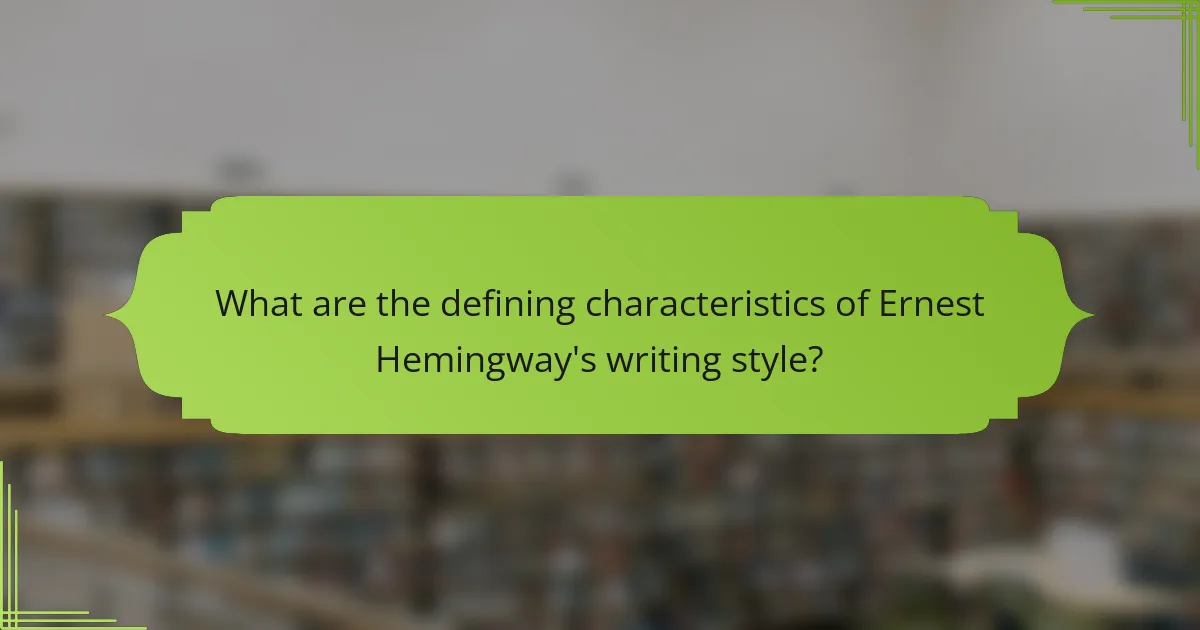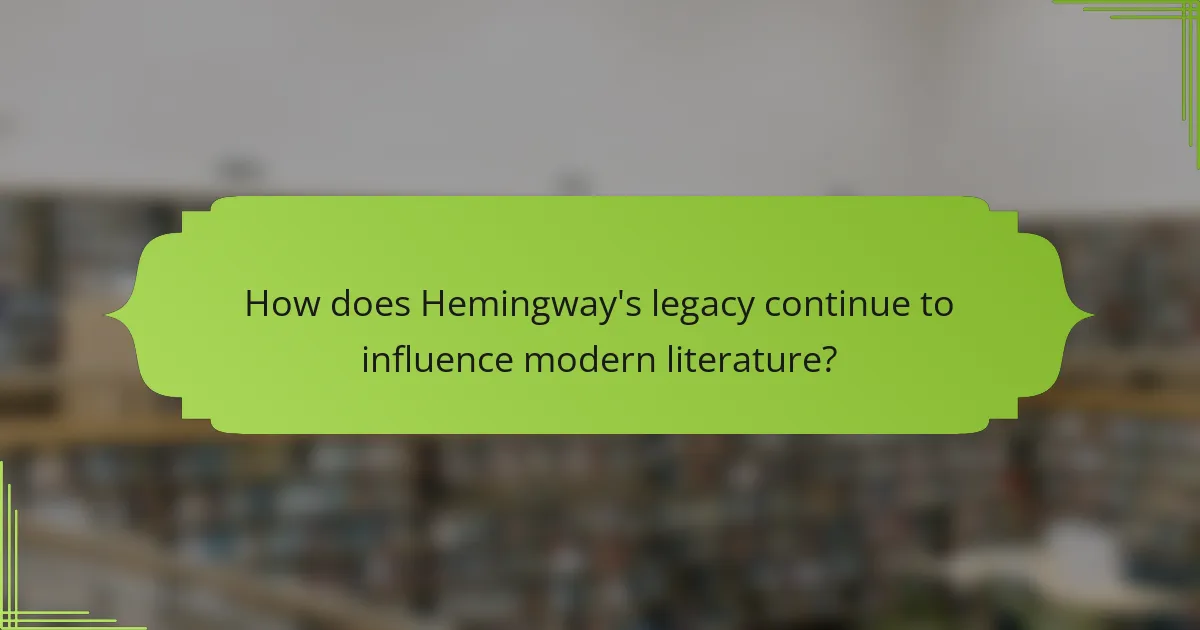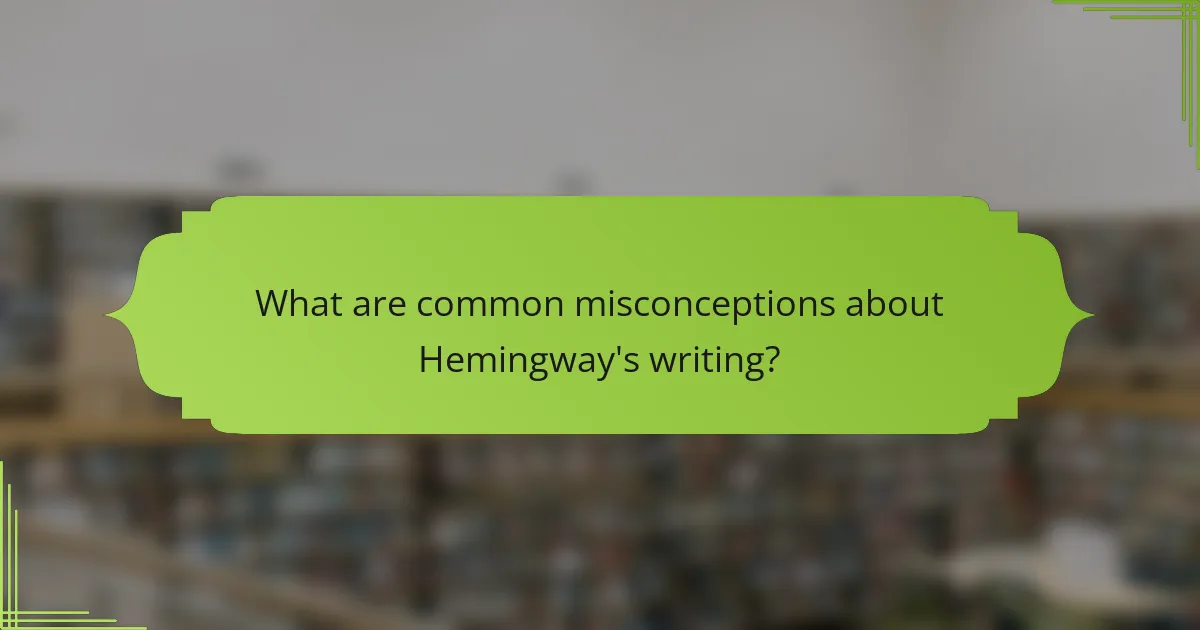Ernest Hemingway’s writing style offers valuable insights into concise storytelling and emotional depth. This article explores his distinctive prose, shaped by personal experiences and journalistic influences. It also examines his iconic works, including “The Old Man and the Sea” and “A Farewell to Arms,” highlighting themes of love, loss, and resilience. Finally, we address common misconceptions about his writing and its lasting impact on modern literature.

What are the defining characteristics of Ernest Hemingway’s writing style?
Ernest Hemingway’s writing style is characterized by simplicity, brevity, and understated emotion. He often employs short sentences and minimalistic descriptions, allowing readers to infer deeper meanings. His unique approach, known as the “Iceberg Theory,” emphasizes subtext, suggesting that much remains unsaid beneath the surface. Hemingway’s prose is direct, often reflecting his experiences as a journalist and soldier, which shapes his unique narrative voice.
How does Hemingway’s use of language impact his storytelling?
Hemingway’s use of language creates a stark, impactful storytelling style characterized by simplicity and precision. His minimalist approach, often referred to as the “Iceberg Theory,” allows readers to infer deeper meanings beneath the surface. This technique enhances emotional resonance and engages the reader’s imagination. Hemingway’s unique attribute of concise dialogue and vivid imagery brings characters and settings to life, making his iconic works memorable. The rare use of short, declarative sentences contributes to a rhythmic flow, facilitating an immersive reading experience.
What role does minimalism play in his narratives?
Minimalism plays a crucial role in Hemingway’s narratives by emphasizing simplicity and clarity. His writing style, characterized by short sentences and sparse descriptions, allows readers to engage deeply with the underlying emotions and themes. This approach reflects his belief in the power of subtext, where much is conveyed through what is left unsaid. Hemingway’s unique attribute of using the “Iceberg Theory” further illustrates this, as he conveys profound truths beneath a surface of simplicity. By stripping away excess, he invites readers to interpret and connect with the story on a personal level.
How does Hemingway’s dialogue contribute to character development?
Hemingway’s dialogue enhances character development by revealing internal conflicts and emotions through minimalist exchanges. His distinctive style often employs subtext, allowing readers to infer deeper meanings behind characters’ words. This technique fosters a sense of realism and intimacy, drawing readers into the characters’ psychological landscapes. Moreover, the sparse nature of his dialogue contrasts with the rich contexts of his narratives, emphasizing the characters’ struggles and motivations.
Which literary techniques are prevalent in his works?
Ernest Hemingway’s works prominently feature techniques such as minimalism, symbolism, and the iceberg theory. His minimalist approach emphasizes brevity and simplicity, allowing readers to infer deeper meanings. Symbolism often enriches his narratives, providing layers of interpretation. The iceberg theory, where much of the story’s substance lies beneath the surface, invites readers to engage actively with the text. These techniques collectively define his distinctive literary style.

What influences shaped Hemingway’s literary voice?
Ernest Hemingway’s literary voice was shaped by his experiences in World War I, his journalistic background, and his distinctive minimalistic style. His time as an ambulance driver in the war influenced themes of loss and resilience in his writing. Hemingway’s journalism honed his ability to convey complex emotions with simplicity, resulting in a unique narrative technique. Additionally, his interactions with contemporary writers, such as Gertrude Stein and F. Scott Fitzgerald, further refined his voice, emphasizing brevity and clarity. These influences collectively contributed to his iconic status in modern literature.
How did his experiences in World War I affect his writing?
Ernest Hemingway’s experiences in World War I profoundly shaped his writing style and themes. The war exposed him to trauma and loss, which influenced his portrayal of human suffering and resilience. His use of terse prose reflects the stark realities he witnessed. Additionally, themes of courage, disillusionment, and the search for meaning permeate his iconic works, such as “A Farewell to Arms.” These elements underscore the impact of his wartime experiences on his literary voice and narrative approach.
Which authors and literary movements inspired Hemingway?
Ernest Hemingway was influenced by several authors and literary movements, notably modernism and the lost generation. Key figures include F. Scott Fitzgerald, Gertrude Stein, and Mark Twain. Modernism shaped his concise style, while the lost generation’s themes of disillusionment resonate in his works.
What cultural contexts influenced his perspectives and themes?
Ernest Hemingway’s perspectives and themes were shaped by his experiences in war, travel, and personal relationships. His participation in World War I influenced his portrayal of masculinity and existentialism. Additionally, his time spent in Paris during the 1920s exposed him to modernist ideas and fellow expatriates, enriching his narrative style. The influence of nature and outdoor life, especially in his later works, reflects his deep connection to the environment. These cultural contexts contribute to the unique attributes of his writing, such as minimalism and the “iceberg theory.”
![]()
What are some of Hemingway’s most iconic works?
Ernest Hemingway’s most iconic works include “The Old Man and the Sea,” “A Farewell to Arms,” “The Sun Also Rises,” and “For Whom the Bell Tolls.” These novels showcase his distinctive writing style, characterized by concise prose and deep themes. “The Old Man and the Sea” won the Pulitzer Prize in 1953, exemplifying his unique ability to convey profound human experiences through simple language. “A Farewell to Arms” explores love and loss against the backdrop of World War I, while “The Sun Also Rises” captures the disillusionment of the Lost Generation. “For Whom the Bell Tolls” addresses the complexities of war and sacrifice. Each work reflects Hemingway’s mastery of storytelling and his influential presence in American literature.
What themes are explored in “The Old Man and the Sea”?
“The Old Man and the Sea” explores themes of struggle, perseverance, and the relationship between man and nature. The narrative illustrates the protagonist’s battle against the marlin, symbolizing personal challenges and human resilience. Additionally, it delves into isolation and the quest for meaning in life. Hemingway’s minimalist style enhances these themes, allowing readers to reflect deeply on the old man’s journey. The story ultimately emphasizes dignity in defeat and the enduring spirit of humanity.
How does “A Farewell to Arms” reflect Hemingway’s personal experiences?
“A Farewell to Arms” reflects Hemingway’s personal experiences through its themes of love and war. The novel draws from his time as an ambulance driver in World War I, showcasing the emotional and physical toll of conflict. Hemingway’s sparse writing style mirrors his own struggle with expressing deep emotions, emphasizing the stark realities of life. Additionally, the protagonist’s relationships echo Hemingway’s own romantic experiences, illustrating the complexities of love amidst chaos. This blend of personal history and literary technique creates a profound narrative that resonates with readers.
Which elements make “For Whom the Bell Tolls” a significant novel?
“For Whom the Bell Tolls” is significant due to its exploration of themes like love, sacrifice, and the impact of war. Hemingway’s concise prose and use of dialogue enhance emotional depth. The novel reflects his experiences during the Spanish Civil War, showcasing the brutality and moral dilemmas faced by individuals. Unique attributes include its nonlinear narrative and rich symbolism, which resonate with readers. The work remains a powerful commentary on the human condition and the interconnectedness of lives.

How does Hemingway’s legacy continue to influence modern literature?
Hemingway’s legacy profoundly influences modern literature through his distinctive writing style and thematic exploration. His concise prose and focus on the human condition resonate with contemporary authors. The “iceberg theory,” emphasizing subtext, shapes narrative techniques today. Writers like Raymond Carver and Cormac McCarthy reflect Hemingway’s minimalist approach, highlighting emotional depth through sparse language. Additionally, themes of war, love, and existentialism in his works continue to inspire new generations of writers, reinforcing the relevance of his literary contributions in modern storytelling.
In what ways do contemporary authors draw from Hemingway’s style?
Contemporary authors often emulate Hemingway’s style through concise prose, minimalism, and subtext. They focus on showing rather than telling, creating emotional depth with sparse language. This technique enhances reader engagement and mirrors Hemingway’s iceberg theory, where the underlying meaning is more significant than the surface narrative. Additionally, authors draw from his themes of stoicism and existentialism, reflecting characters grappling with internal conflicts and the human condition.
How have adaptations of his works shaped public perception?
Adaptations of Ernest Hemingway’s works have significantly influenced public perception by highlighting his themes of resilience and existentialism. These adaptations, whether in film, theater, or literature, often emphasize his unique writing style characterized by succinct prose and vivid imagery. For instance, adaptations like “The Old Man and the Sea” have showcased the struggle against nature, reinforcing Hemingway’s portrayal of human endurance. As a result, audiences often perceive Hemingway as a symbol of the modernist literary movement, shaping a legacy that transcends his original texts.

What are common misconceptions about Hemingway’s writing?
Many misconceptions exist about Hemingway’s writing, often oversimplifying his style and themes. One common belief is that Hemingway’s prose is entirely minimalist. While he is known for his succinctness, his works often contain rich subtext and complex emotional layers. Another misconception is that he only wrote about war and masculinity. In reality, his themes encompass a wide range of human experiences, including love, loss, and nature. Additionally, some readers view his characters as one-dimensional, failing to recognize their depth and complexity shaped by personal struggles. Lastly, the belief that Hemingway’s writing is devoid of emotion overlooks the profound feelings conveyed through his understated narrative style.
How does the myth of the “Hemingway code hero” misrepresent his characters?
The myth of the “Hemingway code hero” misrepresents his characters by oversimplifying their complexities. Hemingway’s protagonists often exhibit vulnerability and emotional depth, contrasting with the stoic, idealized image of the code hero.
This misrepresentation stems from a narrow interpretation of masculinity in his works. Critics often highlight the façade of bravery and detachment but overlook the internal struggles and moral dilemmas faced by characters like Jake Barnes in “The Sun Also Rises.”
Moreover, the myth ignores the influence of Hemingway’s personal experiences, including war trauma and relationships, which deeply inform his characters’ motivations and actions. His writing style, characterized by brevity and understatement, further complicates the perception of his characters, inviting readers to explore their psychological nuances rather than adhering to a simplistic archetype.
In summary, the “Hemingway code hero” myth limits understanding of the rich emotional landscapes in Hemingway’s iconic works, reducing multifaceted characters to mere symbols of stoicism.
What are the implications of Hemingway’s personal life on his literary reputation?
Hemingway’s personal life significantly impacts his literary reputation, intertwining his experiences with his narrative style. His struggles with mental health and relationships often reflect in his themes of isolation and courage. The adventurous persona he cultivated added to his mystique, enhancing public interest in his works. Critics note that his tumultuous life experiences, including war and love, enriched his storytelling, making it resonate with authenticity. The complex interplay between his life and art continues to shape how readers and scholars perceive his contributions to literature.

What practical insights can writers gain from studying Hemingway?
Writers can gain valuable insights into concise storytelling, character development, and emotional depth by studying Hemingway. His use of the “iceberg theory” emphasizes subtext, encouraging writers to convey meaning through implication rather than explicit detail. Analyzing his iconic works, such as “The Old Man and the Sea,” reveals his mastery of simplicity and rhythm, which can enhance any writer’s style. Additionally, understanding Hemingway’s influences, including war experiences and personal struggles, can inspire writers to draw from their own lives for authenticity.
Which writing techniques can aspiring authors adopt from his works?
Aspiring authors can adopt several writing techniques from Ernest Hemingway’s works. His signature concise prose emphasizes clarity and simplicity, encouraging writers to eliminate unnecessary words. Hemingway’s use of the “Iceberg Theory” illustrates deeper themes through subtext, prompting authors to convey meaning without overt explanation. Additionally, his focus on dialogue captures authentic human interaction, allowing writers to develop characters through their speech. Lastly, Hemingway’s mastery of descriptive imagery enhances the reader’s experience, guiding them to visualize scenes vividly.
What common pitfalls should writers avoid based on Hemingway’s experiences?
Writers should avoid excessive complexity, self-indulgence, and over-editing based on Hemingway’s experiences. He emphasized clarity and brevity. Writers often lose their voice by trying to impress rather than communicate effectively. Additionally, Hemingway’s struggles with perfectionism highlight the danger of overthinking, which can stifle creativity.